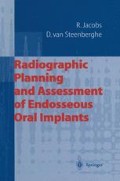Abstract
Over the past two decades, much research has been carried out to develop radiographic methods that improve the ability to detect and measure the jaw bone level. A conventional intra-oral radiograph is a relatively crude tool to quantify and qualify the jaw bone due to:
-
variations in projection geometry
-
variations in contrast and density of the radiographs
-
two-dimensional nature of the radiographic image (overlapping of anatomic structures)
-
uncontrolled film processing
-
variability in peak kilovoltage (kVp)/exposure time
Access this chapter
Tax calculation will be finalised at checkout
Purchases are for personal use only
Preview
Unable to display preview. Download preview PDF.
Author information
Authors and Affiliations
Rights and permissions
Copyright information
© 1998 Springer-Verlag Berlin Heidelberg
About this chapter
Cite this chapter
Jacobs, R., van Steenberghe, D. (1998). Bone Quantity. In: Radiographic Planning and Assessment of Endosseous Oral Implants. Springer, Berlin, Heidelberg. https://doi.org/10.1007/978-3-642-80424-3_5
Download citation
DOI: https://doi.org/10.1007/978-3-642-80424-3_5
Publisher Name: Springer, Berlin, Heidelberg
Print ISBN: 978-3-642-80426-7
Online ISBN: 978-3-642-80424-3
eBook Packages: Springer Book Archive

